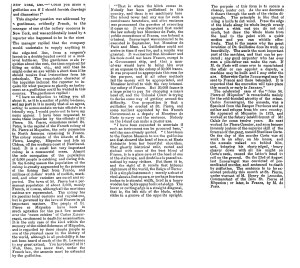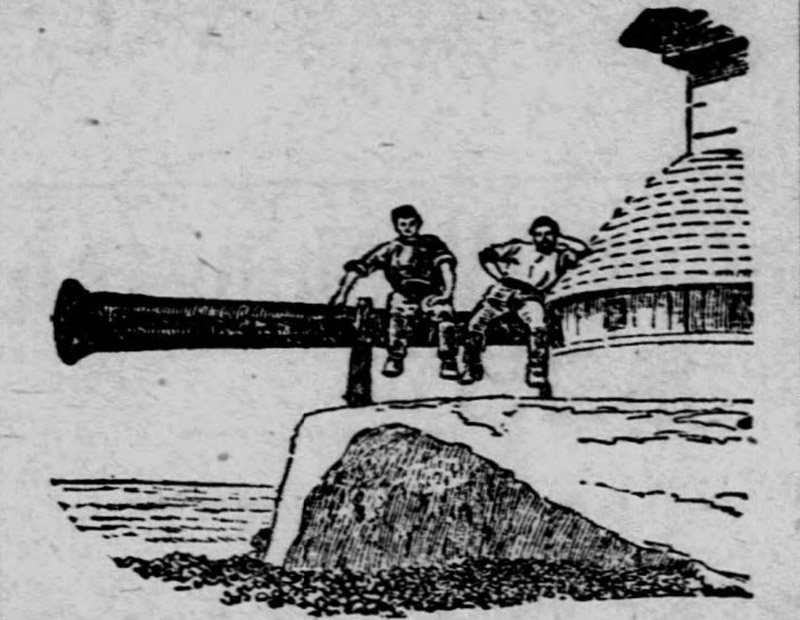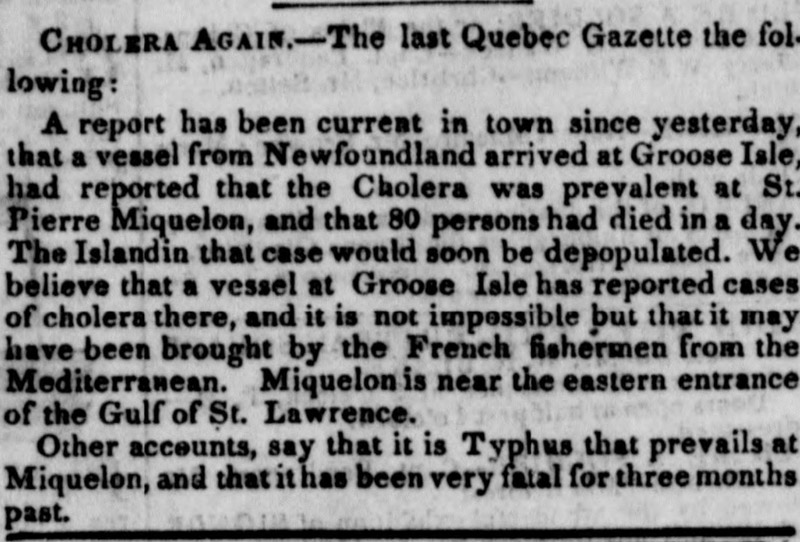New York Sun: Saturday, January 1, 1887
AN AX FOR A GUILLOTINE.
A DECAPITATION CAUSING TROUBLE
Shall an Executioner be Brought from Paris or the Murderer be Taken Across the Sea to be Beheaded?
 « Could you make a guillotine if I should furnish drawings « . This singular question was addressed by a gentleman, evidently French, to the manager of one of the largest cutlery concerns in New York, and was accidentally heard by a reporter who happened to be in the store. The manager replied that the company would undertake to supply anything in the edge tool line, from a surgeon’s lancet to a double-handed sword or a medieval battle-ax. The gentleman made inquiries about the cost, the time required for filling the order, etc., and said he might order an ax within a short time if he should receive final instructions from his principals. The remarkable character of the inquiries induced the reporter to inquire for what purpose so ghastly an instrument as a guillotine could be wanted in this country. The gentleman replied: « I have no objection to telling you all about it, as it is a matter of public business; but as my part in it is merely that of an agent, acting to accommodate certain officials in a friendly way, I would prefer not to have my name appear. I have been requested to make these inquiries by the officials of St. Pierre.
« Could you make a guillotine if I should furnish drawings « . This singular question was addressed by a gentleman, evidently French, to the manager of one of the largest cutlery concerns in New York, and was accidentally heard by a reporter who happened to be in the store. The manager replied that the company would undertake to supply anything in the edge tool line, from a surgeon’s lancet to a double-handed sword or a medieval battle-ax. The gentleman made inquiries about the cost, the time required for filling the order, etc., and said he might order an ax within a short time if he should receive final instructions from his principals. The remarkable character of the inquiries induced the reporter to inquire for what purpose so ghastly an instrument as a guillotine could be wanted in this country. The gentleman replied: « I have no objection to telling you all about it, as it is a matter of public business; but as my part in it is merely that of an agent, acting to accommodate certain officials in a friendly way, I would prefer not to have my name appear. I have been requested to make these inquiries by the officials of St. Pierre.
St. Pierre, sometimes called St. Peter’s, is the capital of the French colony of St. Pierre et Miquelon, the only possession in North America remaining to France. The colony consists of the islands of St. Pierre, Langley, Miquelon and Isle aux Chiens, off the southern coast of Newfoundland. It is a small but very important colony in a commercial sense. Almost the sole occupation of the population of 3000 people is catching and curing fish. By some ancient treaty the colony has certain fishing privileges on the Newfoundland coast and banks, which causes more or less ill feeling between the people of St. Pierre and Newfoundland Is.
The fishing season the population of the colony is greatly augmented by the presence of the fishing fleet from France, and millions of dollars worth of codfish, mackerel and other varieties are cured and ex ported. The town of St. Pierre has a permanent population of about 3000, mostly French, of course, although all the maritime nations are represented. It is a quaint town, built wholly of stone, and being so far from any populous country the people are simple and unsophisticated. They are all good Catholics, and the island of St. Pierre has its convent. These facts give you something of an idea of the character of the colony and its inhabitants. They have their peculiar local customs and regulations, but are governed by the laws of France in all important matters. The little colony of Pierre et Miquelon has been in much agitation for the past live months over the « cause celebre » of Carlos Zuzuaregui, condemned to death for assassination. It is the only case of the kind within the memory of the oldest fishermen of Miquelon, and is regarded by those simple people as one of the greatest cases in the history of the world, although in all probability it has not been heard of south of the St. Lawrence to any great extent. You have heard of it? Well, then, you know that under the French law the assassin must be executed by the guillotine. That is where the hitch comes in. Nobody has ever been guillotined in this country, and there is no machine here. The islands never have had any use for such a contrivance heretofore, and after sentence was pronounced, the question of executing it came up. It was discovered that under the law nobody but Monsieur de Paris, the public executioner of France, can behead a criminal. Zuzuaregui was sentenced to be executed in September, but Monsieur de Paris and Madame la Guillotine could not arrive in time, if sent for, and a respite was granted. It was learned that Monsieur and his tools could not leave France except in a government ship, and that a man-of war would have to bring him over at an expense to the colony of France. It was proposed to appropriate this sum for the purpose, and if all other methods fail, the money will be appropriated and Monsieur invited to visit the very interesting colony of France. But 80.000 [30.000? ndlr] francs is a large price to pay for chopping a man’s head off, and the colonial courts trying to devise some way of getting around the difficulty. One proposition is that a guillotine be erected at St. Pierre and some resident appointed by the French government a deputy of Monsieur de Paris to carry out the sentence. Nobody on the islands can make a proper ax. I have been requested to ascertain if such an instrument can be procured said the man already quoted. « I have been to the Boston museum to see the guillotine ax that sheared the head of innocent Marie Antoinette from her beautiful shoulders ». That ghastly historical relic, rusted and stained with some of the best blood of France, is in a glass case at the head of one of the stairways, and she is passed unnoticed by many visitors. But there it is and the sight of it recalls that hideous nightmare of the world, the reign of terror. It Is a simple instrument; merely a sheet of steel about a foot square, or perhaps fourteen inches in horizontal width, in a heavy wooden bar by its upper horizontal edge. The lower or cutting edge is a straight diagonal, that is, the left side of the blade, which slides in a groove of the guillotine frame, is three or four inches shorter than the right side, which fits the groove of the opposite upright. The purpose of this form is to secure a cleaner, neater cut. As the ax descends it shears through the neck of the victim diagonally. The principle is like that of using a knife to cut wood. Press the edge of the blade along its whole length evenly against a stick and you do not cut much, but draw the blade from the heel to point with a quick motion and you can whittle it effectively. That is why the great invention of Dr. Guillotin does its work so beautifully. The ax is the most important part of the machine, and, it that can be procured, any good carpenter who has ever seen a pile-driver can make the rest. Monsieur de Paris will come over to tend the affair, or can appoint a deputy, a machine may be built and I may order the ax. Otherwise Carlos Zuzuaregui may be sent to France and there beheaded. It is expected that the execution will take place this month or early in January. »
The celebrated case of the Isles Saint Pierre et Miquelon is remarkable mainly for the cold-blooded atrocity of the crime end the total absence of provocation. Carlos Zuzuarregui, the assassin, is a Spaniard from the Basque provinces, and a very bad specimen of a peculiarly bad race. The Basques are such incorrigible depredators and brigands that three prefects of police ere required in a district containing no more people than are controlled by one prefect in other provinces. They are a turbulent, sullen, lawless lot, and notoriously handy with his knife. Zuzuaregui is typical Basque and outlaw and a refugee from his native country. He fled from Europe to escape punishment for numerous crimes, and it was supposed that a murder was his last achievement at home.
He made his appearance at Miquelon in 1873, being then 28 years old, probably knowing that there were about eighty Spaniards on the islands, and expecting to find friends among them. He obtained employment from Mr. Calais in the fisheries, and worked for him about twelve years. Three years alter his arrival he married a fisherman’s widow, who had quite a family of children. Mr. Calais says the man a faithful workman, and did not display a violent temper while in his employ, but he is the only man in the colony who says a word in his favor, and it is supposed that Mr. Calais must be a very good servant or easily deceived person. Zuzuaregui left his employ for some insignificant reason, some petty pique at favor shown to another workman. His reputation in the [island] was that of a violent, bad tempered brawler, a drunkard, and brutal wife beater. It was a common thing for him to beat his wife and children, and he frequently threatened to kill his neighbors on the smallest pretext. In 1878 he was sent to jail for stealing fish, and in 1875 he served a 10-days sentence for brutally assaulting his stepson and cutting an ugly gash in his wife’s lip when she interfered. He was always threatening to murder somebody with his big splitting knife, and he frightened his mother-in-law nearly to death by vowing that he would nail her to a cross. His wife and others testified at his trial that he often got up in the night and paced the floor, muttering frightful imprecations upon all whom he regarded as enemies, and threatening to murder the whole world. These cheerful peculiarities of temperament were attributed by some to nightmare, and by others to delirium tremens. At all events, he was not the peaceable citizen that Mr. Calais supposed him to be. After leaving the employ of Mr. Calais he went to work in June, 1886, for Pierre Cormier. Stanislas Coste went to work for Cormier at the same time. Coste was In every respect the opposite of Zuzuaregui. He was a skillful, industrious workman, and a quiet, good-natured, simple-hearted fellow. He had a wife and six children, of whom he was very fond, and treated them with kindness. Coste had one little weakness of the most harmless kind. He was very proud of his skill as a workman, but there was no arrogance in his pride nothing offensive in his manner or showing it. Because of his skill and fidelity he was made foreman of a gang. This merely made him a leader in the work without increasing his wages. Zuzuaregui worked in the same gang and was fiercely jealous of Stanislas because the latter found favor in the eyes of their employer. Stanislas boasted, and with reason, that he could stack fish faster than any man in the colony. Carlos was lazy and slovenly in his work, but he resented Coste’s superiority, and told stories to injure him. Nobody believed the stories, and the Spaniard’s hate increased because of his failure to poison the mind of Pierre Cormier against his foreman. Then the murderous nature of the Basque outlaw began to show the 22nd of July be was heard muttering that he would kill Stanislas, but as he was always threatening to till somebody his mutterings were not seriously heeded. But he was actually meditating murder tout time. He told the police: « I asked my heart that day I kill this and my heart answered, yes ». They were packing fish in […] Carlos asked the man next to Stanislas to step out and give him the place. He wanted to get next to Stanislas and feed his jealousy by watching Stanislas do good work. Zuzuaregui purposely did his own work as he could so as to attract the foreman’s attention, hoping to get a rebuke that would enrage him and give him even that slim excuse for an attack. Stanislas noticed the bad job and said, laughingly, « What a queer pile you are making of that fish. You are not doing very well », Then after a pause, he added: « Oh, no one at Saint Pierre can stack fish as well us I. » Zuzuaregui rejoined angrily: « Bah! I can myself” but Stanislas made no reply, and the Spaniard threw down his work and went away cursing. The next morning he came to work half an hour late, looking as though he had slept but little or had been drinking the night before. From 6 to 8 am the men were employed in carrying slabs to roof a storehouse. Then they had breakfast from 8 to half past. For the next hour and a half they worked on the storehouse, and at 10 marched to lunch. At noon there was another lunch. In Pierre Cormier’s fish yard lunch was furnished about every hour and a half, for the fishermen of St. Pierre et Miquelon have great appetites, and Pierre Cormier believed that no man could work well when he was hungry. During this day Stanislas and [Carlos] were not working near each other. Part of the time they were passing fish to the storehouse, just as buckets are passed at a fire, and the two men were at opposite ends of the line. The Spaniard said Coste called him names after the quarter past 10 o’clock lunch, but nobody heard any such thing, and doubtless it was an afterthought of the Spaniard’s. Shortly after 11 o’clock Stanislas Coste was at work in an alley on his knees, and a man named Hacala was nailing up tierces some thirty feet distant. Zuzuaregui walked into the alley with a very nervy and keen-edged cleaver in his hand, the back of the tool resting on his shoulder. He stepped up close to Stanislas, who was kneeling, and asked Hacala if enough tierces or crates had been made. The question dispelled any suspicion that Stanislas may have had, and he did not look up. Hacala replied that he didn’t know. Zuzuarregui rejoined: « Well, I know. There have been plenty of them and without another word or any warning he brought the cleaver down with all his strength upon Stanislas Coste’s neck. Coste’s head rolled upon the ground. Hacala and several others saw the thing done, but they were so frightened that they all ran away as fast as their legs could carry them. They after- ward explained their flight by saying that the murder was so unprovoked and horrible that they supposed the Basque to be a madman or a demon. Zuzuarregui went to the police and surrendered himself. He boasted of his deed and said he killed Stanislas « because he took all the credit of the work to himself. » He gave no other reason at that time, and maintained his air of bravado until the trial, when he made a weak attempt to justify himself by declaring Stanislas called him names and worked him up to a frenzy. This was proved to be false, and the Basque was convicted on the 23rd of August, in the Court of Assises, of assassination, or premeditated murder, and sentenced to death by guillotine. That sentence is to be executed probably this month in Saint-Pierre under warrant of M. Henry de Lamothe, commandant, of the Isles Saint Pierre et Miquelon, or later in France by Monsieur de Paris. As Stanislas Coste’s head rolled at the feet of the Basque outlaw, so will the head of Carlos Zazuarregui fall into the basket beneath the guillotine. New York Sun.



Une réflexion sur « 1887 – Affaire Zuzuaregui: New York Sun »